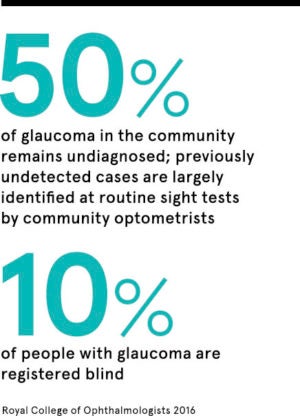According to research by the Royal National Institute for Blind People (RNIB), 14 million people in Britain are not having their eyes tested every two years as recommended by the College of Optometrists.
And, although according to a 2018 YouGov poll 70 per cent of people value their sight more than any other sense, there are up to one million people in the UK with some degree of preventable sight loss.
One of the main causes of avoidable sight loss is something that seldom presents symptoms in its early stages and is often called the “silent thief of sight”, the condition known as glaucoma.
The most common form of glaucoma progresses slowly causing the death of nerve fibres in the optic nerve, which connects the eye to the brain. This results in a gradual loss of peripheral vision in the affected eye that often goes unnoticed at first.
“People often won’t know they have it until it’s fairly advanced and by that time any vision loss is pretty much irreversible,” says Dr Nigel Best, Specsavers’ clinical spokesman.
“We are encouraging people, but especially the over-40s, to have regular eye examinations every two years to check for early signs of glaucoma so they can be referred for early treatment to protect their sight.”
Glaucoma can be difficult to diagnose, but OCT technology is a game-changer as it significantly enhances our ability to spot glaucoma at an earlier stage
The RNIB advises a biennial eye examination even if there is no change in vision, but its figures show that 14 million adults in Britain have not had their eyes tested for more than two years.
The International Glaucoma Association (IGA) estimates 700,000 people in the UK have the condition, but around 50 per cent are unaware they have it and glaucoma worsens if not detected. At the point of diagnosis, men are 16 per cent more likely than women to have significant sight loss, probably because of a traditional male reluctance to engage with healthcare.
“The vision loss is so gradual that people don’t notice it; you can lose up to 40 per cent of vision before it becomes apparent,” says Karen Osborn, IGA chief executive.
“Glaucoma is characterised by misty, patchy vision in the peripheral field. One of the reasons it goesunnoticed is that the brain is wonderful at filling in the gaps from images provided by the optic nerve, while the eyes work together with overlapping fields of vision which compensates for weaknesses.”
 IGA is funding research to develop treatments, cures and improved testing methods that will deliver earlier diagnoses.
IGA is funding research to develop treatments, cures and improved testing methods that will deliver earlier diagnoses.
“Glaucoma is complex and there is no cure at the moment, which makes having regular eye examinations so important,” says Ms Osborn. “Losing your sight can have a huge impact on your life and your independence. One of the things I’d love never to hear again is ‘I wish I’d had my eyes tested’. The impact of delaying can be profound.”
Specsavers is now spearheading a national programme to reduce avoidable sight loss drastically by introducing optical coherence tomography (OCT) scanning equipment in all its stores.
The non-invasive imaging machine enables optometrists to detect minute changes in the retina and optic nerve that can highlight glaucoma up to four years earlier than traditional methods.
“OCT can measure down to a couple of microns – a micron is a millionth of a metre – to give us an accurate assessment of the thickness of the retinal nerve fibre layer, which is a very good indicator of glaucoma,” explains Dr Best.
“Glaucoma can be difficult to diagnose, but this technology is a game-changer as it significantly enhances our ability to spot glaucoma, and other sight-threatening conditions, at an earlier stage. The OCT scans the optic nerve and measures the thickness of the nerve fibres present.
“It then compares this thickness measurement with measurements taken from thousands of similar patients to indicate to an optometrist whether the thickness is as expected or thinner than expected, which can indicate glaucoma.
“An optometrist will consider the OCT findings in conjunction with other more traditional signs of glaucoma, for example eye pressure, and decide whether referral for further investigation is necessary.
“It is a quick, easy and painless examination. The patient simply positions their chin on a rest and feels nothing as the machine takes less than a minute to scan each eye.
“If we can start treatment at an early stage, then vision loss will hopefully be minimal and most glaucoma patients will have no disease progression. However, most patients will need to put in eye drops daily for the rest of their lives to preserve their sight.”
Specsavers is committed to raising awareness of preventable sight loss and making it easier for people to have regular eye examinations that can protect their sight.
For more information please visit specsavers.co.uk

